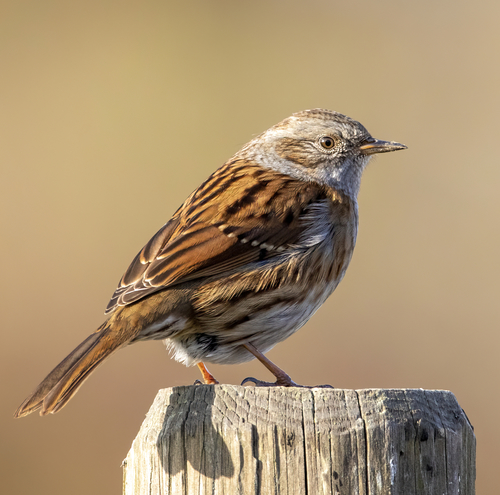
Dunnock
The Dunnock (Prunella modularis) is a small, unassuming passerine bird often mistaken for a sparrow. Despite its drab appearance, the Dunnock plays a vital role in its ecosystem, primarily as an insectivore, helping to control insect populations. It is widespread across Europe and parts of Asia, adapting to various habitats. Interestingly, the Dunnock is known for its complex mating systems, which have been the subject of extensive behavioral studies, revealing fascinating insights into avian social dynamics. It is a very common garden bird in much of its range.
13.5-14.5 cm
Length
19-21 cm
Wingspan
Least Concern
Conservation Status
Distribution
The Dunnock is found throughout Europe and into parts of Western Asia. It extends from Scandinavia and Russia in the north to the Iberian Peninsula, Italy, and the Balkans in the south. Eastern populations reach as far as the Ural Mountains. Some populations are migratory, moving south for the winter, while others are resident.
Lifespan
Typically 2-3 years in the wild, but can live longer.
Dunnock's Habitat
Habitat Types
Woodlands, Hedgerows, Gardens, Parks, Scrubland, Farmland with hedges
Climate Zones
Temperate, Boreal
Adaptations
Dunnocks are adaptable to a range of habitats, showing a preference for areas with dense undergrowth for cover and foraging. Their relatively small size allows them to navigate through thick vegetation.
Variations
Several subspecies of Dunnock have been described, differing subtly in plumage and size. These variations are often linked to geographic isolation and local environmental conditions.
Appearance
Breeding Plumage
Plumage is relatively consistent year-round, with subtle differences. Breeding plumage may show slightly richer colors.
Seasonal Feather Changes
Minor seasonal changes; may appear slightly duller in winter.
Sex Based Plumage Differences
Males and females are very similar in appearance, with only subtle differences in plumage that are difficult to distinguish in the field.
Notable Features
Streaked brown upperparts, Greyish-blue head and breast, Thin, pointed bill, Reddish-brown legs
Diet and Feeding
Primary Foods
Insects, Spiders, Seeds, Small invertebrates
Foraging Behavior
Dunnocks primarily forage on the ground, often shuffling along with a distinctive creeping movement, searching for food among leaf litter and low vegetation. They may also glean insects from foliage.
Specializations
Their thin, pointed bill is well-suited for picking up small insects and seeds.
Seasonal Diet Variations
Diet shifts seasonally. Insects and invertebrates are the primary food source during the breeding season, while seeds become more important in winter when insects are scarce.
Behavior
Social Structure
Dunnocks have a complex social structure. While often seen singly or in pairs, their mating systems can involve multiple males and females in shared territories.
Communication
A thin, high-pitched 'tseep' call, A warbling song, often delivered from a concealed perch, Wing-flicking displays during courtship and territorial disputes
Migration
Northern populations are migratory, moving south for the winter. Southern populations are often resident or only make short-distance movements.
Territorial or Group Behaviors
Dunnocks are territorial during the breeding season. The size and defense of territories vary depending on the mating system and resource availability.
Conservation
Threats
Habitat loss due to agricultural intensification, Pesticide use reducing insect prey, Predation by domestic cats, Climate change affecting habitat and food availability
Protection Programs
General habitat conservation measures benefiting farmland birds, Agri-environment schemes promoting hedgerow management
Local National Laws
Protected under various national wildlife legislation across its range.
Population Trend
Stable
Population Estimates
The global population is estimated to be in the tens of millions.
Interesting Facts
Dunnocks have complex and variable mating systems.
They can be monogamous, polygynous (one male with multiple females), polyandrous (one female with multiple males), or polygynandrous (multiple males and females sharing a territory).
They are frequent hosts of the Common Cuckoo.
Cuckoos lay their eggs in Dunnock nests, leaving the Dunnock parents to raise the cuckoo chick.
Dunnocks' shuffling movement is distinctive.
They often move along the ground with a creeping, mouse-like gait.
Faqs about Dunnock
What is the difference between a Dunnock and a House Sparrow?
Dunnocks have a thinner bill, a greyish-blue head and breast, and a more streaked back compared to the House Sparrow. Their behavior is also different; Dunnocks are more often seen creeping along the ground.
Do Dunnocks migrate?
Some populations, particularly those in northern Europe, migrate south for the winter. Others are resident or only move short distances.
What do Dunnocks eat?
Their diet consists mainly of insects and other small invertebrates during the breeding season, and seeds during the winter.
Where do Dunnocks build their nests?
They build cup-shaped nests in dense vegetation, often low to the ground in hedges, shrubs, or thick undergrowth.
Copyright @ Nature Style Limited. All Rights Reserved.
 English
English